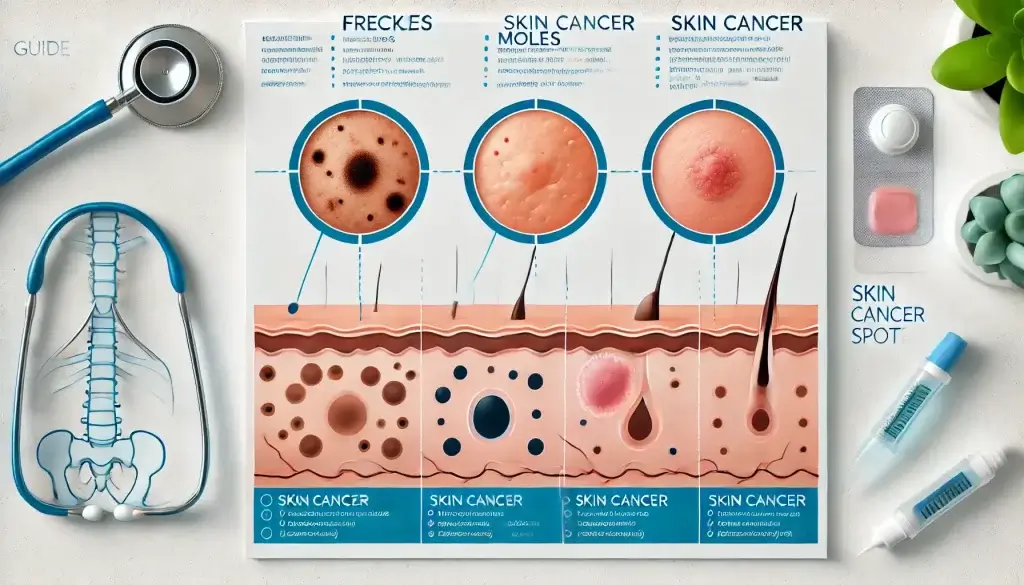At some point or another, we’ve all examined a spot or mole on our skin and wondered, “Is this normal?” Freckles and moles are incredibly common and, for the most part, harmless features of our skin. But on rare occasions, they can be an early warning sign of skin conditions like melanoma, a type of skin cancer. Knowing what to look for is crucial for your health and peace of mind.
This guide will walk you through the key differences between freckles, moles, and spots that might require a closer look from a dermatologist. Along the way, we’ll also discuss how essential it is to regularly check for skin cancer and what to do if something looks suspicious.
By the end of this blog, you’ll feel more confident in distinguishing between a harmless spot and a potential concern.
 What Are Freckles?
What Are Freckles?
Freckles often feel like the playful, sun-loving siblings of the skin world. They appear as small, flat, and light-to-dark brown spots most commonly seen on areas exposed to the sun, such as the face, arms, and shoulders. Freckles develop due to genetics and sun exposure, and they’re especially common in individuals with lighter skin tones.
The good news? Freckles are completely harmless. Unlike moles, freckles don’t develop into anything concerning and are simply clusters of cells with extra pigmentation. However, they’re a sign that your skin can be more sensitive to sun damage. If you have freckles, it’s a great reminder to lather on sunscreen before heading out.
Quick Facts About Freckles:
- Appearance: Small, flat, tan or reddish spots.
- Cause: UV exposure and genetics.
- Risk: Generally harmless but a marker for sun sensitivity.
What Are Moles?
Moles are like the more serious, introvert cousins of freckles—they come in all shapes and sizes but require a bit more attention. Moles are raised or flat spots caused by clusters of melanocytes, the skin cells responsible for pigment. They can appear anywhere on the body and may be various shades of pink, brown, or black.
Most people get moles during childhood or adolescence. Over time, they can change slightly in color, size, or elevation. For the most part, moles are completely benign, but occasionally, they can become problematic.
This is why keeping tabs on your moles is essential. If you notice sudden changes in a mole or have a spot growing rapidly out of the blue, it might be time to check for skin cancer.
Keep An Eye Out For:
- Changes in size, color, or shape.
- Bleeding, itching, or crusting.
- A mole that looks significantly different from others (the “ugly duckling”).
When to Be Concerned About Skin Cancer
While freckles and moles are typically harmless, some skin spots can be an indicator of something more serious like melanoma—a potentially life-threatening form of skin cancer. Melanoma often starts as an unusual or irregular mole or spot.
This is where the ABCDE rule comes in handy for spotting suspicious moles:
- A – Asymmetry: One half doesn’t match the other.
- B – Border: Irregular, blurry, or uneven edges.
- C – Color: Uneven colors, including black, brown, tan, white, or even red and blue.
- D – Diameter: Larger than 6 millimeters (about the size of a pencil eraser).
- E – Evolving: Any change in shape, color, size, or symptoms like itching or bleeding.
If you notice any of these signs, don’t panic, but act promptly. A dermatologist can perform a thorough skin examination and biopsy if needed. Early detection makes a huge difference—it can literally save your life.
How to Check for Skin Cancer (And Why It’s Crucial)
Skin cancer, particularly melanoma, is on the rise worldwide. Checking your skin regularly for changes is one of the simplest habits to protect your health. It doesn’t have to be complicated or time-consuming.
How to Perform a Skin Check:
- Find a well-lit room and a full-length mirror.
- Examine your body from head to toe, including less visible areas like your scalp, the soles of your feet, and between your fingers.
- Take photos of moles and freckles to track any changes over time.
- If you notice anything unusual, schedule an appointment with a dermatologist.
Pro tip: Set a reminder every few months to repeat your self-exam. Prevention is key, and catching abnormalities early is vital for effective treatment.
Reducing Your Risk of Skin Cancer
While genetics play a role in skin cancer risk, there’s plenty you can do to lower your chances of developing it. Here are some practical tips:
- Wear broad-spectrum sunscreen with SPF 30 or higher every day, even on cloudy days.
- Seek shade during peak sun hours (10 AM – 4 PM).
- Avoid tanning beds entirely.
- Wear protective clothing, hats, and sunglasses outdoors.
- Keep skin moisturized and hydrate—healthy skin is better at protecting itself.
Celebrate Your Skin with Knowledge
Understanding the differences between freckles, moles, and potential cancerous spots gives you the power to make informed decisions about your health. Your skin is your largest organ and first line of defense, so it deserves some TLC and regular attention.
If you’re someone with freckles, moles, or both, approach them with curiosity and care—not fear. Build the habit of regular self-checks and never hesitate to ask your dermatologist about anything unusual. After all, it’s always better to be safe than sorry.
To learn more about skin care, protection, or early detection of skin cancer, check out [Link to reputable resource or service].
Stay sun-safe, stay informed, and love the skin you’re in!
